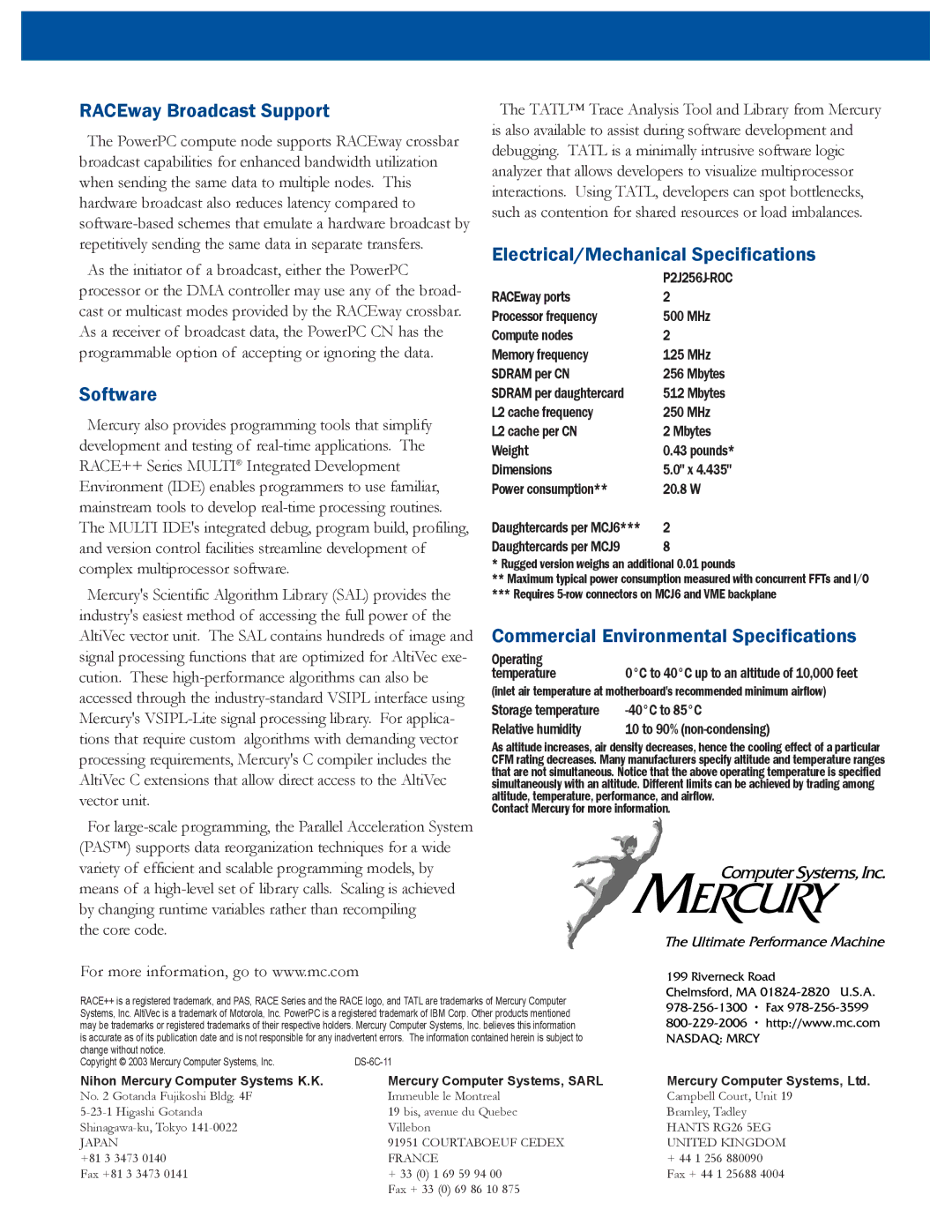
RACEway Broadcast Support
The PowerPC compute node supports RACEway crossbar broadcast capabilities for enhanced bandwidth utilization when sending the same data to multiple nodes. This hardware broadcast also reduces latency compared to
As the initiator of a broadcast, either the PowerPC processor or the DMA controller may use any of the broad- cast or multicast modes provided by the RACEway crossbar. As a receiver of broadcast data, the PowerPC CN has the programmable option of accepting or ignoring the data.
Software
Mercury also provides programming tools that simplify development and testing of
Mercury's Scientific Algorithm Library (SAL) provides the industry's easiest method of accessing the full power of the AltiVec vector unit. The SAL contains hundreds of image and signal processing functions that are optimized for AltiVec exe- cution. These
The TATL™ Trace Analysis Tool and Library from Mercury is also available to assist during software development and debugging. TATL is a minimally intrusive software logic analyzer that allows developers to visualize multiprocessor interactions. Using TATL, developers can spot bottlenecks, such as contention for shared resources or load imbalances.
Electrical/Mechanical Specifications
| |
RACEway ports | 2 |
Processor frequency | 500 MHz |
Compute nodes | 2 |
Memory frequency | 125 MHz |
SDRAM per CN | 256 Mbytes |
SDRAM per daughtercard | 512 Mbytes |
L2 cache frequency | 250 MHz |
L2 cache per CN | 2 Mbytes |
Weight | 0.43 pounds* |
Dimensions | 5.0" x 4.435" |
Power consumption** | 20.8 W |
Daughtercards per MCJ6*** | 2 |
Daughtercards per MCJ9 | 8 |
*Rugged version weighs an additional 0.01 pounds
**Maximum typical power consumption measured with concurrent FFTs and I/O
***Requires
Commercial Environmental Specifications
Operating | 0°C to 40°C up to an altitude of 10,000 feet |
temperature | |
(inlet air temperature at motherboard's recommended minimum airflow) | |
Storage temperature | |
Relative humidity | 10 to 90% |
As altitude increases, air density decreases, hence the cooling effect of a particular CFM rating decreases. Many manufacturers specify altitude and temperature ranges that are not simultaneous. Notice that the above operating temperature is specified simultaneously with an altitude. Different limits can be achieved by trading among altitude, temperature, performance, and airflow.
Contact Mercury for more information.
For
the core code.
For more information, go to www.mc.com
RACE++ is a registered trademark, and PAS, RACE Series and the RACE logo, and TATL are trademarks of Mercury Computer |
| |
Systems, Inc. AltiVec is a trademark of Motorola, Inc. PowerPC is a registered trademark of IBM Corp. Other products mentioned |
| |
may be trademarks or registered trademarks of their respective holders. Mercury Computer Systems, Inc. believes this information |
| |
is accurate as of its publication date and is not responsible for any inadvertent errors. The information contained herein is subject to |
| |
change without notice. |
|
|
Copyright © 2003 Mercury Computer Systems, Inc. |
| |
Nihon Mercury Computer Systems K.K. | Mercury Computer Systems, SARL | Mercury Computer Systems, Ltd. |
No. 2 Gotanda Fujikoshi Bldg. 4F | Immeuble le Montreal | Campbell Court, Unit 19 |
19 bis, avenue du Quebec | Bramley, Tadley | |
Villebon | HANTS RG26 5EG | |
JAPAN | 91951 COURTABOEUF CEDEX | UNITED KINGDOM |
+81 3 3473 0140 | FRANCE | + 44 1 256 880090 |
Fax +81 3 3473 0141 | + 33 (0) 1 69 59 94 00 | Fax + 44 1 25688 4004 |
| Fax + 33 (0) 69 86 10 875 |
|
